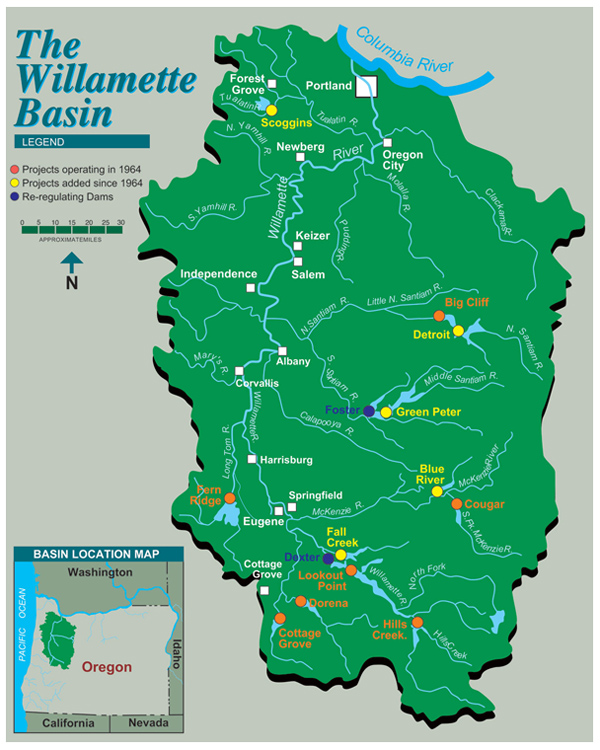With warm, dry weather forecasted, the U.S. Army Corps of Engineers, Portland District, is refilling its 13 Willamette Valley Project reservoirs and two Rogue River Basin Project reservoirs to prepare for the spring and summer conservation seasons.
Refill season, which begins in February and ends in May, is crucial for the reservoir systems to adequately fill before summer.
Both the Willamette and Rogue reservoir systems, which largely depend on rainfall to drive and sustain inflows, experienced a dry winter and spring. As a result, reservoirs aren’t at the ideal water levels to prepare for the dry summer months ahead.
The National Weather Service forecast a warm and dry spring, further highlighting the need for more precipitation.
The Corps manages reservoir inflows based on a “rule curve,” or the authorized maximum elevation on a given day to balance flood risk and storage for authorized purposes. Both systems’ reservoirs are kept lower in the winter in an effort to reduce downstream flooding and refilled in the spring to prepare for recreation and adequate flows for fish.
Winter snowpack supplements inflows in the late summer months, as snow in high elevations melts and travels downstream into reservoirs. Snowpack equates to less than 10 percent of each system’s storage.
Corps water management experts say there is still time for a significant rain event, like last year’s April atmospheric river event, but this timeframe narrows as summer nears.
Portland District dams and reservoirs support a variety of the Corps’ authorized purposes to include flood risk management, fish and wildlife, hydropower generation and recreation.
The public is encouraged to visit the Portland District website to check the “teacup diagrams” before heading out to recreate. View water elevations, inflows and outflows, what boat ramps are in the water, and more. https://www.nwp.usace.army.mil/Missions/Flood-Risk-Management/Forecasts/
As of March 24, the below information represents current conditions at both locations.
Willamette Valley Project:
The Willamette Valley Project’s 13 reservoirs are currently 35% full. System-wide reservoir elevations are 30-feet below the rule curve. Year-to-date precipitation in the Valley is 74% of average. Willamette Basin snowpack is currently 84% of average.
From North to South, Detroit reservoir is 34% full, Green Peter reservoir is 40% full, Foster reservoir is 50% full, Blue River is 43% full, Fern Ridge is 35% full, Fall Creek is 33% full, Cougar reservoir is 37% full, Dorena is 30% full, Cottage Grove is 33% full, Lookout Point is 32% full and Hills Creek is 29% full. Big Cliff and Dexter reservoirs act as re-regulating reservoirs rather than storage reservoirs in that they capture peak flow releases from dams upstream, hold and then steadily release water downstream.
Rogue River Basin Project:
The Rogue River Basin Project’s two reservoirs are currently 62% full. System-wide reservoir elevations are 20-feet below the rule curve. Year-to-date precipitation in the Rogue Basin is 68% of average. Rogue River Basin snowpack is currently 68% of average.
Lost Creek reservoir is 70% full, sitting 16-feet below rule curve. Applegate is 26% full, sitting 38-feet below rule curve.

